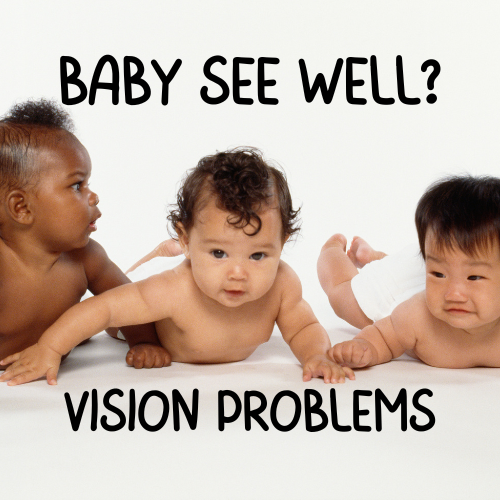Infant Vision Problems – Does Your Baby See Well?


Learn to identify infant vision problems.
Babies can be born with or develop vision problems and learning how to recognize the signs of eye problems can help you spot issues so they can be treated early.
When babies are born, their vision is not yet sharp and clear. The shape of the eye at birth does not allow images to be seen in sharp focus.As the baby grows so do the baby’s eyes. In addition, the baby’s brain is growing and learning to process visual images by developing connections and networks.
Infant Eyes Need time to Develop
During the first month, a baby’s eyes may appear crossed. That’s because their eyes are not yet well coordinated and can’t yet track together. The ability to focus their eyes and use them together has to be learned. When the infant is about five months old their eyes are typically working together to form a three-dimensional view.
A newborn is sensitive to bright light, and their main focus is on close objects about 10 inches away from their face. A newborn baby also does not have the eye muscle strength to track objects well.
By eight weeks, babies can more easily focus their eyes on the faces of a parent or other person near them.
Your pediatrician will check your baby’s eyes for proper development at every appointment. If anything looks amiss or may need further attention, you will likely be given a referral to see a pediatric ophthalmologist.
Signs of Infant Vision Problems
You are the person who sees your baby everyday and you may be able to spot something that was missed during a checkup. Here are signs of possible infant vision problems to watch for:
- One eye that turns inward or outward. Babies may look cross-eyed at times but if you continue to notice that one eye turns in or out, talk to your pediatrician.
- Continually tilting the head to one side to look at things. Continual head tilting to view objects may indicate a problem with eye muscle control.
- Excessive tearing. It is completely normal for babies to produce some tears when they cry, but if your baby is experiencing excessive tearing, it could be caused by a blocked tear duct.
- Inability to track objects with the eyes by about three months. Babies develop at different rates, but if your baby’s eyes are not working together to track objects by about three months, it is a good idea to talk with your doctor to rule out a visual coordination problem.
- Red eyelids. Red eyelids can be a sign of infection, especially if the eyelids are red and crusted.
- Extreme sensitivity to light. All newborns are sensitive to bright light but if after a month or two your baby is still extremely sensitive to light let your baby’s doctor know.
Diagnosing vision problems as early as possible is an important step in ensuring your baby’s optimal visual development.
Gregory Scimeca, M.D.
Ophthalmologist and Medical Director
The Eye Professionals
Our Locations
